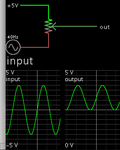Rocketman46
Member level 3
Hi all,
I need a bit of advice on what opamp configuration i should use.
I am using a dual supply opamp -5v and +5v and i require the output to swing between 0v to 5v, whilst the input swings between -5v to +5v. I usually work with opamps with inputs between 0v to 5v, but the +/- input has confused me.
Look forward to your reply.
Thanks,
Rocketman46
I need a bit of advice on what opamp configuration i should use.
I am using a dual supply opamp -5v and +5v and i require the output to swing between 0v to 5v, whilst the input swings between -5v to +5v. I usually work with opamps with inputs between 0v to 5v, but the +/- input has confused me.
Look forward to your reply.
Thanks,
Rocketman46



